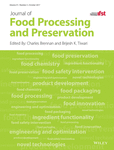Effects of High Intensity Pulsed Electric Fields or Thermal Treatments and Refrigerated Storage on Antioxidant Compounds of Fruit Juice-Milk Beverages. Part II: Carotenoids
Abstract
Effects of high intensity pulsed electric fields (HIPEF) or thermal treatments over carotenoids of mixed beverages were evaluated after processing and during refrigerated storage. Nine carotenoids were identified in all samples, being β-carotene the major compound. Just after processing, concentration of most individual carotenoids diminished around 6–30% in fruit juice-skim milk (FJ-SM) and fruit juice-whole milk (FJ-WM) beverages; except, 9-cis-violaxanthin-neoxanthin, antheraxanthin and phytoene-phytofluene which increased in the thermally treated FJ-SM (5–19%) and 9-cis-violaxanthin-neoxanthin which also augmented in HIPEF processed FJ-SM (24%). Total carotenoid (TC) content decreased (6–13%) in both beverages, irrespectively of the treatment applied. Through the storage, individual carotenoid concentration varied widely in all beverages, depending on the carotenoid structure; however, TC tended to decrease. Nonetheless, changes observed HIPEF-treated beverages were less than those in the conventionally pasteurized ones. Hence, HIPEF is as effective treatment, or even more, than heat processing to preserve bioactive compounds in mixed beverages.
Practical Applications
Nowadays, modern population is claiming for products with high antioxidant properties and attractive flavor. In this sense, mixed beverages formulated with fruit juices and milk are attracting the attention of consumers due to their exotic taste and their elevated concentration of bioactive substances, such as carotenoids. However, these compounds are very susceptible to heat and are easily degraded during processing and storage. Hence, finding preservation technologies for mixed beverages capable to maintain their carotenoid concentration as high as possible after treatment and during shelf-life is one of the greatest challenges for the food industry. In this sense, the relevance of this study is to demonstrate that high intensity pulsed electric fields processing is a potential alternative to thermal pasteurization in order to obtain not only safe but nutritious fruit juice-mixed beverages with elevated concentration of carotenoids, especially those with pro-vitamin A activity, such as β-carotene.




